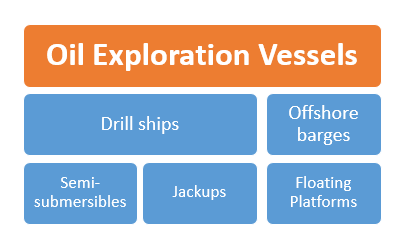What are Offshore Fleets?
Offshore Fleets are ships that precisely serve operational drives such as construction work and oil exploration and at the high seas. The size of these vessels varies between 20 - 100 meters. They are good at achieving a variety of tasks in the supply chain.
Offshore ships also provide the transiting and relieving of crewing personnel to and from the high seas’ operational areas, as and when necessitated.
Offshore Fleets can be mainly classified into the following main groups:
- Oil exploration vessels
- Offshore construction vessels
- Excavation, diving support vessels
- Supply/repair vessels
- Offshore production vessels
Each of this category comprises of a variety of vessels.
Oil Exploration Vessels
These vessels hold the charge for oil exploration and collection on the high seas. Here the various ships and offshore expertise used in the oil industry.
- Drill ships
- Jackups
- Semi-submersibles
- Offshore barges
- Floating Platforms

Supply and repair vessels offshore vessels provide the necessary manpower and technical reinforcement required bring in the needed supplies, fuel, consumables etc. Many repair vessels come equipped with specific systems for sub-sea inspection, maintenance and repair, as well as ranging the capabilities of the operation.
.png)
• Anchor Handling Tug Vessel (AHTV)
• Seismic Vessel
• Platform Supply Vessels (PSVs)
• Well Intervention Vessel
• Accommodation Ships
Diving support vessels
Diving support vessels provide the essential manpower and technical strengthening required so that the operational processes in the high seas continue efficiently and without any undesired disruptions.
Some of the main types of offshore support vessels are:
• Anchor Handling Tug Vessel (AHTV)
• Seismic Vessel
• Platform Supply Vessels (PSVs)
• Well Intervention Vessel
• Accommodation Ships
.png)
Offshore Construction Vessel
As a construction project moves through its plan, different apparatuses and skills are required for each phase. This can include pipe laying, anchoring, crane vessels, surveying, examination and much more.
These vessels provide anchorage and tugging support and those kinds of ships that help in the positioning of deep sub-water cable and piping lines.
Offshore construction vessels provide support from outside the main structure, including angles that can’t be expanded while on the ship.
Main types are:
• Diving Support Vessel
• Crane Vessel
• Pipe Laying Vessel
.png)
Offshore production vessels
These vessels help in the production procedures in the drilling units in the high seas.
• Floating Production Storage and Offloading (FPSO)
• Single Point Anchor Reservoir (SPAR) platform
• Shuttle Tankers
• Tension Leg Platform (TLP)
.png)
Search for Offshore vessel jobs at Oceancrew. We offer different vacancies that can turn into the subject of your interest. Choose either a maritime job or offshore one you would like to attend and get detailed information about the vacancy
Looking for information about Offshore job vacancy? We make the suggestion for the applicants of different nationalities – OceanCrew help to find the well-paid maritime job for willing candidates from every corner of the world
More news
5 Biggest Oil Rigs in the World
Oil rigs are some of the biggest manmade structures in the world. Most of these impressive sized platforms draw oil from the depths with the help of complicated engineering. Oil rig jobs are one of the most rewarding jobs in the industry. Here is a list of the five biggest oil rigs in the world.
READ NEWSHow to become an oil rig driller?
Did you know that an oil rig driller makes an average of $18.31 an hour? That's approx. $38,100 a year! We at Oceancrew offer different vacancies that can turn into the subject of your interest. Choose either maritime job or offshore one you would like attend and get the detailed information about the vacancy!
READ NEWS
